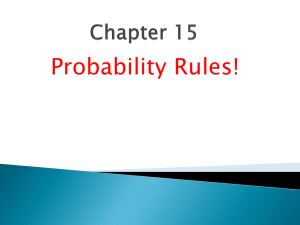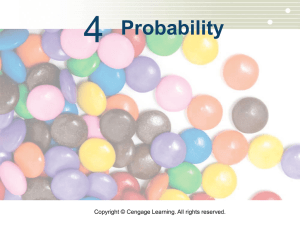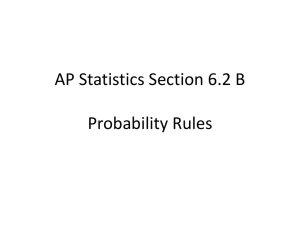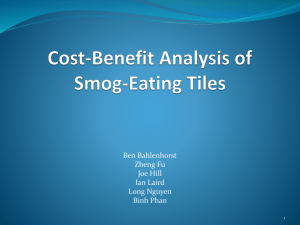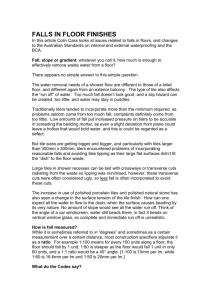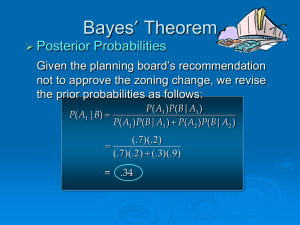Probability of Independent and Dependent Events
advertisement
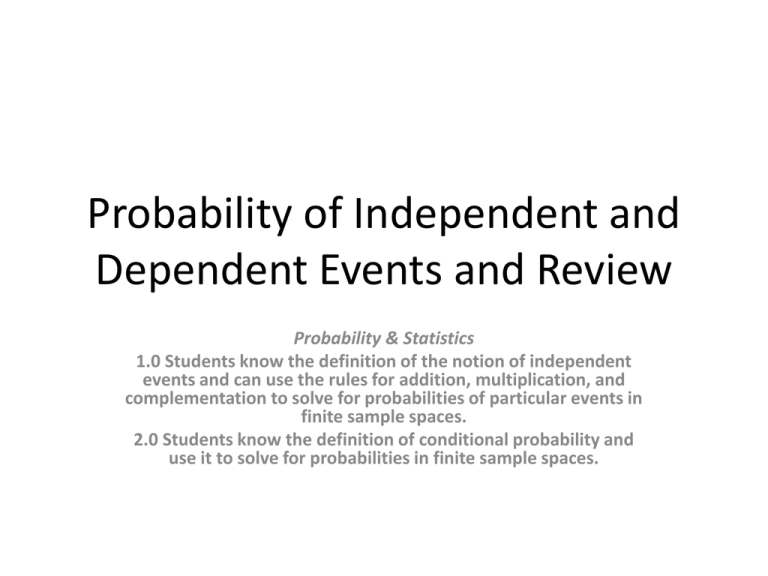
Probability of Independent and Dependent Events and Review Probability & Statistics 1.0 Students know the definition of the notion of independent events and can use the rules for addition, multiplication, and complementation to solve for probabilities of particular events in finite sample spaces. 2.0 Students know the definition of conditional probability and use it to solve for probabilities in finite sample spaces. Probability of Independent and Dependent Events and Review Objectives • Solve for the probability of an independent event. • Solve for the probability of a dependent event. Key Words • Independent Events – The occurrence of one event does not affect the occurrence of the other • Dependents Events – The occurrence of one event does affect the occurrence of the other • Conditional Probability – Two dependent events A and B, the probability that B will occur given that A has occurred. Example 1 Identify Events Tell whether the events are independent or dependent. Explain. a. Your teacher chooses students at random to present their projects. She chooses you first, and then chooses Kim from the remaining students. b. You flip a coin, and it shows heads. You flip the coin again, and it shows tails. c. One out of 25 of a model of digital camera has some random defect. You and a friend each buy one of the cameras. You each receive a defective camera. Example 1 Identify Events SOLUTION a. Dependent; after you are chosen, there is one fewer student from which to make the second choice. b. Independent; what happens on the first flip has no effect on the second flip. c. Independent; because the defects are random, whether one of you receives a defective camera has no effect on whether the other person does too. Checkpoint Identify Events Tell whether the events are independent or dependent. Explain. 1. You choose Alberto to be your lab partner. Then Tia chooses Shelby. ANSWER dependent 2. You spin a spinner for a board game, and then you roll a die. ANSWER independent Example 2 Find Conditional Probabilities Concerts A high school has a total of 850 students. The table shows the numbers of students by grade at the school who attended a concert. a. What is the probability that a student at the school attended the concert? b. What is the probability that a junior did not attend the concert? Did not attend Grade Attended Freshman Sophomore Junior 80 120 132 173 86 29 Senior 179 51 Example 2 Find Conditional Probabilities SOLUTION a. P(attended) = total who attended 80 + 132 + 173 + 179 = 850 total students 564 ~ 0.664 = 850 b. P(did not attend junior) = juniors who did not attend total juniors 29 29 ~ 0.144 = = 173 + 29 202 Checkpoint Find Conditional Probabilities 3. Use the table below to find the probability that a student is a junior given that the student did not attend the concert. ANSWER Did not attend Grade Attended Freshman Sophomore Junior 80 120 132 173 86 29 Senior 179 51 29 ~ 0.101 286 Probability of Independent and Dependent Events • Independent Events – If A and B are independent events, then the probability that both A and B occur is P(A and B)=P(A)*P(B) • Dependent Events – If A and B are dependent events, then the probability that both A and B occur is P(A and B)=P(A)*P(B|A) Example 3 Independent and Dependent Events Games A word game has 100 tiles, 98 of which are letters and two of which are blank. The numbers of tiles of each letter are shown in the diagram. Suppose you draw two tiles. Find the probability that both tiles are vowels in the situation described. a. You replace the first tile before drawing the second tile. b. You do not replace the first tile before drawing the second tile. Example 3 Independent and Dependent Events SOLUTION a. If you replace the first tile before selecting the second, the events are independent. Let A represent the first tile being a vowel and B represent the second tile being a vowel. Of 100 tiles, 9 + 12 + 9 + 8 + 4 = 42 are vowels. P( A and B = P( A • P( B = 42 42 • = 0.1764 100 100 ( ( ( Example 3 Independent and Dependent Events b. If you do not replace the first tile before selecting the second, the events are dependent. After removing the first vowel, 41 vowels remain out of 99 tiles. P( A and B = P( A • P( B| A = 42 41 ~ 0.1739 • 100 99 ( ( ( Checkpoint Find Probabilities of Independent and Dependent Events 4. In the game in Example 3, you draw two tiles. What is the probability that you draw a Q, then draw a Z if you first replace the Q? What is the probability that you draw both of the blank tiles (without replacement)? ANSWER 1 = 0.0001; 10,000 1 ~ 0.0002 4950 Conclusion Summary • How are probabilities calculated for two events when the outcome of the first event influences the outcome of the second event? – Multiply the probability of the second event, given that the first event happen. Assignment • Probability of Independent and Dependent Events – Page 572 – #(11-14,15,18,22,26,30) Review Probability & Statistics 1.0 Students know the definition of the notion of independent events and can use the rules for addition, multiplication, and complementation to solve for probabilities of particular events in finite sample spaces. 2.0 Students know the definition of conditional probability and use it to solve for probabilities in finite sample spaces. Theoretical Probability of an Event Example: What is the probability that the spinner shown lands on red if it is equally likely to land on any section? Solution: The 8 sections represent the 8 possible outcomes. Three outcomes correspond to the event “lands on red.” When all outcomes are equally likely, the theoretical probability that an event A will occur is: Number of outcomes in event 𝐴 𝑃 𝐴 = Total number of outcomes The theoretical probability of an event is often simply called its probability. 3 Number of outcomes in event P(red) = = 8 Total number of outcomes Experimental Probability of an Event Example: Surveys The graph shows results of a survey asking students to name their favorite type of footwear. What is the experimental probability that a randomly chosen student prefers (a) Sneakers? (b) Shoes or boots? For a given number of trials of an experiment, the experimental probability that an event A will occur is: Number of trials where 𝐴 𝑜𝑐𝑐𝑢𝑟𝑠 𝑃 𝐴 = Total number trials Solution: Find the total number of students surveyed. 820+556+204+120=1700 a. Of 1700 students, 820 prefer sneakers. P(prefers sneakers) 820 Number preferring sneakers = Total number of students ~ ~ 0.48 = 1700 b. Of 1700 students surveyed, prefer shoes or boots. P(prefers shoes or boots) = 340 Number preferring shoes or boots Total number of students = 1700 ~ ~ 0.19 Probability of Compound Events • Overlapping Events – If A and B are overlapping events, then P(A and B)≠0, and the probability of A or B is: 𝑃 𝐴 𝑜𝑟 𝐵 = 𝑃 𝐴 + 𝑃 𝐵 − 𝑃(𝐴 𝑎𝑛𝑑 𝐵) • Disjoint Events – If A and B are disjoint events, then P(A and B)=0, and the probability of A or B is: 𝑃 𝐴 𝑜𝑟 𝐵 = 𝑃 𝐴 + 𝑃 𝐵 Probability of the Complement of an Event Recall: Complement of an Event All outcomes that are not in the event The sum of the probabilities of an event and its complement is 1. 𝑃 𝐴 + 𝑃 𝑛𝑜𝑡 𝐴 = 1 So, 𝑃 𝑛𝑜𝑡 𝐴 = 1 − 𝑃(𝐴) Probability of Independent and Dependent Events • Independent Events – If A and B are independent events, then the probability that both A and B occur is P(A and B)=P(A)*P(B) • Dependent Events – If A and B are dependent events, then the probability that both A and B occur is P(A and B)=P(A)*P(B|A)


